単一周波数、超低ノイズレーザー、拡張型バタフライパッケージ
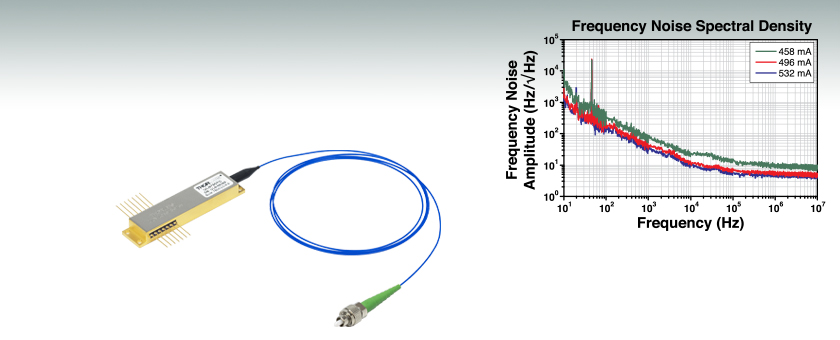
- Wavelengths Targeting Rb and Cs D-Line Transitions,
and the C-Band - Typical Linewidths as Low as 100 Hz
- Typical Relative Intensity Noise (RIN) as Low as -165 dBc/Hz
- Integrated TEC Elements and Thermistors
US Patents: 10193306, 10483718,
10476233, and 10454248
ULN780PC
780 nm Ultra-Low-Noise Laser, Extended Butterfly Package, PM Fiber
Frequency noise of a 1550 nm ultra-low-noise laser at various currents within a region of single mode operation. The peak in noise at 43 Hz is due to HVAC systems present in the testing facility. The data is typical, and performance will vary among individual lasers.

Please Wait
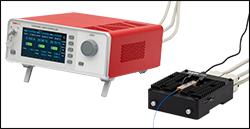 Click to Enlarge
Click to EnlargeFigure 1.1 The LNC31 laser diode driver used with a ULN15PC ultra-low-noise laser diode mounted in a LM14TS active mount.
| Webpage Features | |
|---|---|
| Clicking this icon opens a window that contains specifications and mechanical drawings. | |
| Clicking this icon allows you to download our standard support documentation. | |
|
Choose Item |
Clicking the words "Choose Item" opens a drop-down list containing all of the in-stock lasers around the desired center wavelength. The red icon next to the serial number then allows you to download L-I and spectral measurements for that serial-numbered device. |
Low-Noise, Turnkey Laser Systems
All of the ULN hybrid lasers sold on this page can be incorporated into our low-noise, turnkey laser system platform upon request. Please see our Low-Noise, Narrow-Linewidth Laser Systems for more information.
Features
- Typical Center Wavelengths of 780, 795, 852, or 1550 nm
- Relative Intensity Noise (RIN) as Low as -165 dBc/Hz
- Typical SMSR as High as 70 dB
- 14-Pin Hermetically Sealed Extended Butterfly Package
- Two Integrated Thermoelectric Coolers (TEC) and Thermistors
- PM Fiber Pigtail with 2.0 mm Narrow Key FC/APC Connector
- Compatible with LM14TS Laser Mount
- Requires Low-Noise Current Source, Such as Our LNC31 Low-Noise Laser Diode Driver
Thorlabs' Ultra-Low-Noise (ULN) Hybrid Lasers provide signals with relative intensity noise as low as -165 dBc/Hz and typical (Lorentzian) linewidths as low as 100 Hz. The single mode output can reach optical powers as high as 140 mW with a side mode suppression ratio (SMSR) as high as 70 dB. These specifications are achieved through a patented design consisting of a single angled facet (SAF) gain chip coupled to a fiber Bragg grating (FBG) enclosed in a hermetically sealed case.1 Two integrated thermoelectric coolers (TECs) and thermistor pairs act in a closed loop to control the temperature of the gain chip and FBG independently. In addition, each laser features an auxiliary thermistor that monitors the case temperature and a built-in monitor photodiode.
Lasers with inherently narrow linewidth and low noise require a driver current with minimal current noise, such as our LNC31 low-noise laser diode driver, to reach their specified optical performance. The chosen current supply should be given time to stabilize before the output of the laser is measured. In addition, an optical isolator should be placed at the output of the laser.
Our 1550 nm ultra-low-noise lasers are available in either a current- or temperature-tuning configuration. The lasing spectrum of both of these sources changes between single longitudinal mode and multimode depending on the drive current. As the system experiences effects of hysteresis, the width of these ranges will also change depending on whether the drive current is being increased or decreased. Each laser's center wavelength is tested and reported on a serialized data sheet. Users should reference the laser's individual data sheet to see where these regions exist for their device. More information on the differences between these configurations can be found in the presentation below, as well as the SM Operation tab.
Mounting and Care
Each laser is housed in an extended 14-pin butterfly-style package. This extended package is compatible with the LM14TS Active Butterfly Mount. If not using Thorlabs' mount, the diode must be affixed to a purpose-built heat sink. The laser's case has four mounting slots for use with 2-56 (M2) screws. Note that the ultra-low-noise hybrid lasers are extremely sensitive to both seismic and acoustic vibrations, so a mounting fixture that dampens vibration is suggested. Thorlabs offers packs of fifty 2-56 screws (Item # SH2S019) as well as a 2-56 tap (Item # TAP256) to aid in installation. Mounting torque should not exceed 0.14 N·m (20 oz-in); this can be applied and checked using a torque driver.
Laser diodes are sensitive to electrostatic shock. Please take the proper precautions when handling the device, such as using an ESD wrist strap.
We recommend cleaning the fiber connector before each use in case any dust or other contaminants have been deposited on the surface. The laser intensity at the center of the fiber tip can be very high and may burn the tip of the fiber if contaminants are present. While the connector is cleaned and capped before shipping, we cannot guarantee that it will remain free of contamination after it is removed from the package. We also recommend that the laser is turned off when connecting or disconnecting the device from other fibers.
Applications
With their inherently narrow linewidth and low noise, these lasers are ideal for any application where minimizing the laser linewidth (and therefore, maximizing the coherence length) and its intensity noise is desired. The ULN laser diodes are ideal for applications such as optical sensing, generating optical carriers for RF-over-fiber or coherent optical communication systems in the C-band, vapor cell and cavity locking, neutral atom and ion-based quantum computing, Rydberg atom experiments, and wavemeter stabilization. They can be used for atomic cooling of rubidium (Item # ULN780PC, tuned to the Rb D2 transition, or Item # ULN795PC, tuned to the Rb D1 transition) or cesium (Item # ULN852PC, tuned to the Cs D2 transition).
Thorlabs also offers turnkey versions of our Ultra-Low-Noise (ULN) and Distributed Feedback (DFB) single-frequency laser diodes at 1310 nm and 1550 nm, as well as our 780 or 795 nm Distributed Bragg Reflector (DBR) single-frequency laser diodes. The turnkey solutions integrate our lasers with a low-noise driver and temperature stabilization inside of a benchtop housing. Factory-set for single-frequency operation, these laser systems have a preset drive current and FBG temperature. For more information on the characteristics of different types of single-frequency diodes, see the SFL Overview tab.
1. Morton P, Morton M. "High-Power, Ultra-Low Noise Hybrid Lasers for Microwave Photonics and Optical Sensing." Journal of Lightwave Technology. 2018 November 1; 36: 5048-5057.
シングルモード(単一縦モード)動作
当社の1550 nm ULNシリーズハイブリッドレーザは、シングルモードとマルチモード動作間で変動します。安定した出力領域は様々な要因によって変化します1。ここでは駆動電流によってシングルモードの動作範囲がどのように変動するかを説明しています。注:下記のデータは典型値です。個々の製品で安定したシングルモード動作が得られる駆動電流についてはシリアル番号のデータシートをご参照ください。
縦モードの遷移
シングルモードとマルチモード動作間の変動は、利得チップの高反射の後端面とファイバーブラッググレーティング(FBG)によって生成された共振器内の複数の発振モードによるものです。下のグラフでは、温度でチューニングするレーザULN15PT のシングルモード出力パワーを代表例として示しています。シングルモード範囲間では駆動電流によってマルチモード出力となります。そのため、マルチモード出力パワーはグラフより除外されています。例えば、約220 mAで駆動されたユニットはマルチモード出力、300 mAではシングルモード出力となります。電流でチューニングする構成のレーザは、これらのマルチモードの領域を最小に留めます。
ヒステリシス
1550 nm ULNシリーズハイブリッドレーザのシングルモード領域の幅は常に同じではありません。シングルモード動作が得られた後、電流の増加しているときか減少しているときかによって変動します。下のグラフは電流でチューニングするレーザULN15PCの電流増減時の出力パワーを代表例として示しています。電流を700~725 mAの間で駆動させたときのレーザの性能を見てみましょう。700 mAから電流を上げた場合、出力は約715 mAまでシングルモードにはなりません(下のグラフの赤い曲線)。しかし、シングルモードの領域に入った後は、駆動電流を700 mA近くまで下げても、共振器はシングルモード動作を維持します(青い曲線)。ULNシリーズハイブリッドレーザを駆動時、安定した動作を維持するためには電流の変化の方向に留意することが重要です。
TFBGによる縦モードシフト
ULNシリーズレーザに内蔵するファイバーブラッググレーティング(FBG)の格子周期は温度によって変動します。温度でチューニングするULNレーザをご使用の場合、この温度を個々に設定することにより、共振器の発振モードをサポートし、所望の出力波長にチューニングすることが可能です。しかし、ファイバーブラッググレーティングの温度は発振モードに影響を与えるため、シングルモード領域はシフトします。下のグラフでは、典型的な温度調整型レーザULN15PTのTFBGの調整によるシングルモード動作領域の変動を示しています。温度の変動がある一定以上大きくなると、レーザはシングルモード動作からマルチモード動作にシフトします。レーザがシングルモード動作の領域端となる電流で駆動されている場合、ほんの数度の変動でこのシフトが発生する場合があります。このため、温度によるチューニング時には光スペクトルアナライザでレーザの出力をモニタし、出力がシングルモードを維持していることを確認することをお勧めいたします。
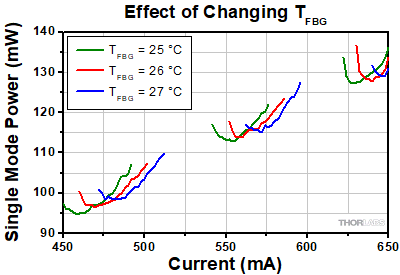 Click to Enlarge
Click to EnlargeClick for Data
Figure 2.3 シングルモードの領域はTFBGの変化によりシフトし、固定の駆動電流ではシングルモード動作から外れる原因となる場合があります。
波長シフト
駆動電流の変動はレーザのモードのほかにも、出力波長のシフトを生じさせる可能性があります。下はULN15PCの波長グラフの代表例です。赤色の点の群はモードホップフリーのシングルモード動作領域を示しています。このような波長と電流の依存性は当社の温度による波長チューニングを行うモデルにも見られます。しかし、これらのモデルはファイバーブラッググレーティング(FBG)の温度を変えることにより、一定のパワーで波長をチューニングします。注:中心波長のステップ状の変動は測定に使用した光スペクトルアナライザの分解能によるものです。波長の変動はシングルモード動作の各領域にわたり滑らかです。
 Click to Enlarge
Click to EnlargeClick for Data
Figure 2.4 シングルモード動作領域内において、中心波長が電流によりシフトします。「Trendline」の各曲線はシングルモード領域を示しています。測定データがステップ状に現れているのは測定に使用した光スペクトルアナライザの分解能によるものです。波長の変動はシングルモード動作の各領域にわたり滑らかです。
1. Morton P, Morton M. "High-Power, Ultra-Low Noise Hybrid Lasers for Microwave Photonics and Optical Sensing." Journal of Lightwave Technology. 2018 November 1; 36: 5048-5057.
拡張型バタフライパッケージのピン配列
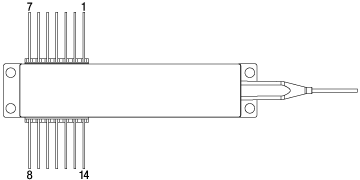
| Pin Identification | |||
|---|---|---|---|
| Pin | Assignment | Pin | Assignment |
| 1 | FBG TEC - | 8 | Photodiode Anode |
| 2 | FBG TEC + | 9 | Laser Diode Anode |
| 3 | Case Thermistor | 10 | Laser Diode Cathode |
| 4 | Case Thermistor | 11 | Chip Thermistor |
| 5 | Photodiode Cathode | 12 | Chip Thermistor |
| 6 | Chip TEC - | 13 | FBG Thermistor |
| 7 | Chip TEC + | 14 | FBG Thermistor |
注: 当社の全てのバタフライおよび拡張型バタフライレーザはフローティング構造です。
ECL、DFB、VHG安定化、DBR、ハイブリッドの単一周波数(SFL)レーザ
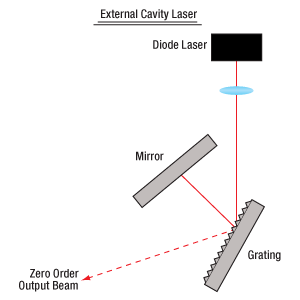
Click to Enlarge
Figure 4.1 ECLは、利得チップの外側に回折格子があります。
レーザの多くの用途では、チューナブルな単一周波数動作が必要になります。単一周波数出力を得るための半導体レーザとしては現在、外部共振型(ECL)、分布帰還型(DFB)、体積型ホログラフィック回折格子型(VHG)、分布ブラッグ反射型(DBR)の主に4種類のレーザがあります。どれも回折格子を使用したフィードバックによって単一周波数を出力します。外部共振型(ECL)ではさらにファイバーブラッググレーティング(FBG)を組み合わせたハイブリッド製品がございます。しかしそれぞれ回折格子のフィードバック構造が異なるので、出力や帯域幅、ならびにサイドモード抑圧比(SMSR)などの性能が異なります。下記では、単一周波数半導体レーザの主な違いについて述べています。
外部共振型レーザ
外部共振型レーザ(ECL)は、その構造により多くの標準的な自由空間半導体レーザに対応します。 つまりECLは、半導体レーザ素子が対応する様々な波長で使用することができるということです。 半導体レーザの出力光はレンズによってコリメートされ、回折格子に入射されます(Figure 4.1参照)。 回折格子はフィードバック(反射)を生じさせ、安定した出力波長を選択するために用いられます。 適切な光学設計により外部共振器が単一縦型のレーザ光のみを選択するため、単一周波数で高サイドモード抑圧比(SMSR> 45 dB)のレーザが出力されます。
ECLのメリットの1つに比較的長い共振器長が超狭線幅(<1 MHz)をもたらすことがあります。 また、様々な半導体レーザを組み込むことができるので、青色ならびに赤色波長において狭線幅の光を放出できる数少ない構造の1つとなっております。 広いチューニングレンジ(>100 nm)を得ることができますが、ECLの機械設計、ならびに半導体レーザの反射防止(AR)コーティングの質によってモードホップする傾向があります。

Click to Enlarge
Figure 4.2 DFBレーザにはアクティブゲイン媒体の長さに沿って、ブラッグ反射鏡が付いています。
分布帰還型レーザ
分布帰還型(DFB)レーザ(近赤外および中赤外) でご提供可能)は半導体レーザ構造内に回折格子が組み込まれているレーザとなっております(Figure 4.2参照)。 アクティブ領域と密結合する波形の周期構造がブラッグ反射鏡として働き、単一縦型のレーザ光モードを選択します。 アクティブ領域がブラッグ周波数近くで十分な利得を得られれば、端面反射鏡は必要なく、代わりにブラッグ反射鏡が全ての光フィードバックならびにモード選択に用いられることになります。 この「内蔵型」の光選択によってDFBレーザは、幅広い温度ならびに電流範囲で単一周波数動作を得ることができるのです。 DFBレーザにはモード選択の補助や歩留り向上のためによく位相シフト部分がレーザ構造内に用いられています。
DFBのレーザ波長は、ブラッグ波長とほぼ等しくなっております。

ここで、λは波長、neffは有効屈折率、Λは回折格子の周期です。 レーザ波長は、有効屈折率を変えることによってチューニングができます。 有効屈折率の変化はDFBレーザの温度ならびに駆動電流のチューニングによって得られます。
DFBレーザは、850 nmでは2 nm、1550 nmでは4 nm、中赤外域(4.00~11.00 µm)では1 cm-1の比較的狭いチューニングレンジとなります。 しかし、このチューニングレンジにわたり単一周波数動作が得られている、つまりこれがモードホップ無しの連続したチューニングレンジであることを意味します。 この特長により、DFBはテレコムやセンサをはじめ、様々な用途で広く使用されています。 DFBの共振器長は比較的短いため、線幅の典型値は1 MHz~10 MHzの範囲内となります。 また、回折格子の構造とアクティブ領域が同じ領域にあるため、DFBの最大光出力は、ECLとDBRレーザに比べて低くなっております。

Click to Enlarge
Figure 4.3 VHGレーザの体積型ホログラフィック回折格子は、アクティブゲイン媒体の外側にあります。
体積型ホログラフィック回折格子型安定化レーザ
体積型ホログラフィック回折格子型(VHG)レーザもブラッグ反射鏡を使用しますが、この場合は、透過型回折格子は半導体レーザ出力の前に置かれます(Figure 4.3参照)。この回折格子は半導体レーザの一部ではないため、半導体レーザからは熱的に分離することが可能で、デバイスの波長安定性が向上します。 この回折格子は、通常は複数種類の屈折率の光学材料(通常はガラス)を周期的に積層する構成です。 ブラッグの条件を満たす波長の光だけが反射してレーザ共振器に戻り、それにより非常に高い波長安定性を有するレーザになります。 VHG安定化レーザは、高パワーにおいて、DFBレーザと同様の線幅で出力可能で、広い範囲の電流および温度にわたって波長がロックされます。
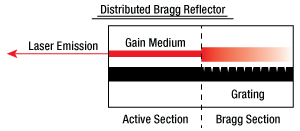
Click to Enlarge
Figure 4.4 DBRレーザのブラッグ反射鏡はアクティブゲイン媒体の外側にあります。
分布反射型レーザ
分布反射型(DBR)レーザは、DFBレーザと同様、回折格子が内部に組み込まれています。 しかしDFBレーザの回折格子はアクティブ(利得)領域に沿っているのに対し、DBRレーザの回折格子は、領域の外側に位置しています(Figure 4.4参照)。 一般的にDBRレーザは典型的なDFBレーザにはない様々な領域を組み込むことが可能なので制御範囲とチューニングレンジがより広くなります。 例えばマルチ電極DBRレーザには位相制御領域があり、回折格子周期や半導体レーザ駆動電流制御とは独立して、位相のみを制御することが可能です。 この制御を共に使用することによってDBRレーザは幅広いチューニングレンジで単一周波数動作が可能となります。 例えば高性能なサンプルグレーティングDBRレーザのチューニングレンジは最大30~40 nmになりえます。 DFBレーザと異なりモードホップフリーではないため、入射ならびに温度を維持できるよう慎重な制御が必要です。
制御構造が複雑なマルチ電極DBRレーザに対し、構造をよりシンプルにしたDBRレーザは単電極のみで設計されています。 単電極DBRレーザには、回折格子ならびに位相制御の複雑構造はありませんが、チューニングレンジはマルチ電極に比べて狭くなります。 チューニングレンジはDFBレーザと同程度になり、駆動電流や温度によってモードホップも生じます。 モードホップのデメリットはありますが、回折格子がデバイスの長さと同じでなければいけない制限はないため、DFBレーザと比べて光出力が大きいなどのメリットもあります。 DBRならびにDFBのレーザの線幅は同程度です。 当社では現在単電極DBRレーザのみをご提供しております。
超低ノイズハイブリッドレーザ
当社の超低ノイズ(ULN)ハイブリッドレーザは、SAF利得チップが比較的長いファイバーブラッググレーティング(FBG)に結合されています。こちらのレーザは外部共振型(ECL)に似たレーザ共振器をファイバの長さに沿って作るよう設計されています。この共振器によりULNシリーズハイブリッドレーザの線幅は約100 Hzと非常に狭く、また相対強度ノイズも-165 dBc/Hz(典型値)と低くなります。ファイバーブラッググレーティング(FBG)の熱的分離を保つ構造を取り、そこで利得媒質から放出される光を部分的に反射させます。格子周期はFBGに熱(その結果かかる熱応力)を加えることで変動させることができます。利得媒質とFBGを独立に温度調整できる構成から、温利得媒質の温度を安定させながら、独立してレーザ出力波長を温度でチューニングします。レーザの構成が優れた低ノイズ性能を発揮するため、レーザ本体がノイズの制限要因になることはないでしょう。レーザの環境をモニタし、振動や音響振動などノイズに寄与する要因を制限し、レーザを低ノイズ電流源で駆動することが重要です。
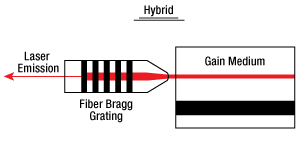
Click to Enlarge
Figure 4.5 当社のハイブリッドレーザは、ファイバーブラッググレーティング(FBG)が利得媒質に結合しています。
結論
ECL、DFB、VHG、DBRならびにハイブリッドレーザは、設計されたチューニングレンジで単一周波数を発振します。ECLは、DFBやDBRレーザよりも幅広い波長の選択が可能となります。モードホップする傾向がありますが、狭い線幅(<1 MHz)をもたらします。適切に設計された機器では、ECLによって超広帯域幅 (> 100 nm)をもたらすことも可能です。
DFBレーザは最も安定した単一周波数レーザです。DFBのレーザーチューニングレンジ(<5 nm)内ではモードホップフリーの性能を発揮するため、単一周波数レーザとして最もご要望の多いレーザです。DFBレーザ特有の連続グレーティングフィードバック構造のため、光出力は最も低くなっております。
VHGレーザは、広い範囲の温度および電流にわたって、波長性能が安定しているため、DFBレーザの典型値よりも高いパワーが可能です。この安定性により組み込み用途(OEM用途)での使用にも適しています。
単電極DBRレーザもDFBレーザ(< 5 nm)に似た線幅とチューニングレンジですが、単電極DBRレーザはチューニング曲線で周期的なモードホップを発生します。
ハイブリッドレーザではノイズが非常に低い信号を得ることができます。この利点を利用するためには、振動ならびに音響振動など不要なノイズ源からレーザを隔離し、低ノイズ電流源で駆動することが必要です。
Thorlabs' ULN lasers, with their inherently narrow linewidth and low noise, require a driver current with minimal current noise to reach their specified optical performance. The LNC31 low-noise laser diode driver is recommended for any application where minimizing the laser linewidth (and therefore, maximizing the coherence length) and its intensity noise is desired.
Figures 5.1 and 5.2 represent the typical performance of a ULN15PC laser mounted in a LM14TS active mount and driven by a LNC31 laser diode driver, compared with the mount and laser driven by a LDC210C controller, and our low-noise turnkey ULN15TK laser system.

Click to Enlarge
Click Here for Data
Figure 5.1 Example frequency noise data of a ULN15PC laser in a LM14TS active mount, driven by the LNC31 laser diode driver, compared with the mount and laser driven by a LDC210C controller, and a low-noise turnkey ULN15TK laser system. Using an LDC210C to drive the laser requires two separate TEC drivers, such as TED200C temperature controller.
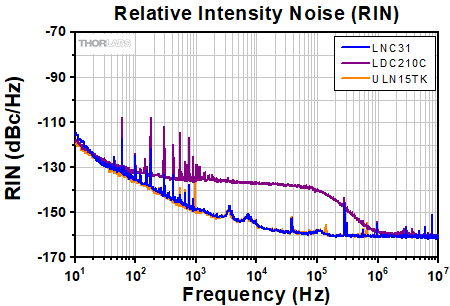
Click to Enlarge
Figure 5.2 The typical relative intensity noise (RIN) of a ULN15PC laser in a LM14TS active mount, driven by the LNC31 laser diode driver, compared with the mount and laser driven by a LDC210C controller, and a low-noise turnkey ULN15TK laser system. Using an LDC210C to drive the laser requires two separate TEC drivers, such as TED200C temperature controller.
Figure 5.3 represents electrical current noise and the relative intensity noise (RIN) for a ULN15PC laser diode, used with the LNC31 low-noise laser diode driver.
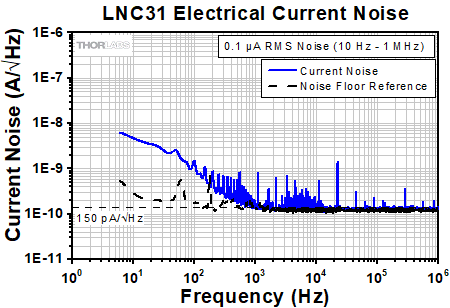
Click to Enlarge
Figure 5.3 Example electrical current noise data for a ULN15PC laser in a LM14TS active mount, driven by the LNC31 laser diode driver. The integrated electrical current noise is 0.1 µA RMS over 10 Hz - 1 MHz.
| Posted Comments: | |
Yi Zhang
(posted 2025-10-02 17:13:26.1) Hello,
We recently purchased a ULN15PC. I'd like to double check if there is an isolator built into the ULN15PC?
Thanks,
Yi Vijayalakshmi Surendranath Shroff
(posted 2022-09-27 12:38:08.5) Dear Sir/Madam,
I am interested with ULN laser series. I kindly request you for a quotation for ULN15 current tuning lasers. Could you please also let me know the coherence length of the laser since I would be interested in characterising the line width of the laser. Can I also know the overall current tuning range of the laser?
Best regards,
Vijayalakshmi S cdolbashian
(posted 2022-10-04 04:03:37.0) Thank you for reaching out to us with this inquiry! A quotation can be requested by contacting our sales team (SALES@THORLABS.COM). The coherence length can be calculated via the linewidth, and is calculated to be ~240km. Current tuning information can be found on the product page by clicking the blue "i" icon, and navigating to the "Current tuning" tab. |
| The rows shaded green below denote single-frequency lasers. |
| Item # | Wavelength | Output Power | Operating Current | Operating Voltage | Beam Divergence | Laser Mode | Package | |
|---|---|---|---|---|---|---|---|---|
| Parallel | Perpendicular | |||||||
| L375P70MLD | 375 nm | 70 mW | 110 mA | 5.4 V | 9° | 22.5° | Single Transverse Mode | Ø5.6 mm |
| L404P400M | 404 nm | 400 mW | 370 mA | 4.9 V | 13° (1/e2) | 42° (1/e2) | Multimode | Ø5.6 mm |
| LP405-SF10 | 405 nm | 10 mW | 50 mA | 5.0 V | - | - | Single Transverse Mode | Ø5.6 mm, SM Pigtail |
| L405P20 | 405 nm | 20 mW | 38 mA | 4.8 V | 8.5° | 19° | Single Transverse Mode | Ø5.6 mm |
| LP405C1 | 405 nm | 30 mW | 75 mA | 4.3 V | 1.4 mrad | 1.4 mrad | Single Transverse Mode | Ø3.8 mm, SM Pigtail with Collimator |
| L405G2 | 405 nm | 35 mW | 50 mA | 4.9 V | 10° | 21° | Single Transverse Mode | Ø3.8 mm |
| DL5146-101S | 405 nm | 40 mW | 70 mA | 5.2 V | 8° | 19° | Single Transverse Mode | Ø5.6 mm |
| L405A1 | 405 nm | 175 mW (Min) | 150 mA | 5.0 V | 9° | 20° | Single Transverse Mode | Ø5.6 mm |
| LP405-MF300 | 405 nm | 300 mW | 350 mA | 4.5 V | - | - | Multimode | Ø5.6 mm, MM Pigtail |
| L405G1 | 405 nm | 1000 mW | 900 mA | 5.0 V | 13° | 45° | Multimode | Ø9 mm |
| LP450-SF25 | 450 nm | 25 mW | 75 mA | 5.0 V | - | - | Single Transverse Mode | Ø5.6 mm, SM Pigtail |
| L450G3 | 450 nm | 100 mW (Min) | 80 mA | 5.2 V | 8.4° | 21.5° | Single Transverse Mode | Ø3.8 mm |
| L450G2 | 450 nm | 100 mW (Min) | 80 mA | 5.0 V | 8.4° | 21.5° | Single Transverse Mode | Ø5.6 mm |
| L450P1600MM | 450 nm | 1600 mW | 1200 mA | 4.8 V | 7° | 19 - 27° | Multimode | Ø5.6 mm |
| L473P100 | 473 nm | 100 mW | 120 mA | 5.7 V | 10 | 24 | Single Transverse Mode | Ø5.6 mm |
| LP488-SF20 | 488 nm | 20 mW | 70 mA | 6.0 V | - | - | Single Transverse Mode | Ø5.6 mm, SM Pigtail |
| LP488-SF20G | 488 nm | 20 mW | 80 mA | 5.5 V | - | - | Single Transverse Mode | Ø5.6 mm, SM Pigtail |
| L488P60 | 488 nm | 60 mW | 75 mA | 6.8 V | 7° | 23° | Single Transverse Mode | Ø5.6 mm |
| LP505-SA15 | 505 nm | 15 mW | 80 mA | 7.0 V | - | - | Single Transverse Mode | Ø5.6 mm, SM Pigtail |
| LP505-SF15 | 505 nm | 15 mW | 80 mA | 7.0 V | - | - | Single Transverse Mode | Ø5.6 mm, SM Pigtail |
| L505P30 | 505 nm | 30 mW | 80 mA | 6.7 V | 8° | 23° | Single Transverse Mode | Ø5.6 mm |
| LP514-SA25 | 514 nm | 25 mW | 140 mA | 5.9 V | - | - | Single Transverse Mode | Ø5.6 mm, SM Pigtail |
| LP514-SF25 | 514 nm | 25 mW | 140 mA | 5.9 V | - | - | Single Transverse Mode | Ø5.6 mm, SM Pigtail |
| L514A2 | 514 nm | 45 mW (Min) | 115 mA | 5.7 V | 8° | 22° | Single Transverse Mode | Ø5.6 mm |
| LP515-SF3 | 515 nm | 3 mW | 50 mA | 5.3 V | - | - | Single Transverse Mode | Ø5.6 mm, SM Pigtail |
| L515A1 | 515 nm | 10 mW | 50 mA | 5.4 V | 6.5° | 21° | Single Transverse Mode | Ø5.6 mm |
| LP520-SF15A | 520 nm | 15 mW | 100 mA | 7.0 V | - | - | Single Transverse Mode | Ø5.6 mm, SM Pigtail |
| L520A1 | 520 nm | 30 mW (Min) | 80 mA | 5.5 V | 8° | 22° | Single Transverse Mode | Ø5.6 mm |
| LP520-SF40 | 520 nm | 40 mW | 190 mA | 6.0 V | - | - | Single Transverse Mode | Ø5.6 mm, SM Pigtail |
| PL520 | 520 nm | 50 mW | 250 mA | 7.0 V | 7° | 22° | Single Transverse Mode | Ø3.8 mm |
| L520P50 | 520 nm | 45 mW | 150 mA | 7.0 V | 7° | 22° | Single Transverse Mode | Ø5.6 mm |
| L520A2 | 520 nm | 110 mW (Min) | 225 mA | 5.9 V | 8° | 22° | Single Transverse Mode | Ø5.6 mm |
| DJ532-10 | 532 nm | 10 mW | 220 mA | 1.9 V | 0.69° | 0.69° | Single Transverse Mode | Ø9.5 mm (non-standard) |
| DJ532-40 | 532 nm | 40 mW | 330 mA | 1.9 V | 0.69° | 0.69° | Single Transverse Mode | Ø9.5 mm (non-standard) |
| LP633-SF50 | 633 nm | 50 mW | 170 mA | 2.6 V | - | - | Single Transverse Mode | Ø5.6 mm, SM Pigtail |
| HL63163DG | 633 nm | 100 mW | 170 mA | 2.6 V | 8.5° | 18° | Single Transverse Mode | Ø5.6 mm |
| LPS-635-FC | 635 nm | 2.5 mW | 70 mA | 2.2 V | - | - | Single Transverse Mode | Ø9 mm, SM Pigtail |
| LPS-PM635-FC | 635 nm | 2.5 mW | 60 mA | 2.2 V | - | - | Single Transverse Mode | Ø9 mm, PM Pigtail |
| L635P5 | 635 nm | 5 mW | 30 mA | <2.7 V | 8° | 32° | Single Transverse Mode | Ø5.6 mm |
| HL6312G | 635 nm | 5 mW | 50 mA | <2.7 V | 8° | 31° | Single Transverse Mode | Ø9 mm |
| LPM-635-SMA | 635 nm | 8 mW | 50 mA | 2.2 V | - | - | Multimode | Ø9 mm, MM Pigtail |
| LP635-SF8 | 635 nm | 8 mW | 60 mA | 2.3 V | - | - | Single Transverse Mode | Ø5.6 mm, SM Pigtail |
| HL6320G | 635 nm | 10 mW | 60 mA | 2.2 V | 8° | 31° | Single Transverse Mode | Ø9 mm |
| HL6322G | 635 nm | 15 mW | 75 mA | 2.4 V | 8° | 30° | Single Transverse Mode | Ø9 mm |
| L637P5 | 637 nm | 5 mW | 20 mA | <2.4 V | 8° | 34° | Single Transverse Mode | Ø5.6 mm |
| LP637-SF50 | 637 nm | 50 mW | 140 mA | 2.6 V | - | - | Single Transverse Mode | Ø5.6 mm, SM Pigtail |
| LP637-SF70 | 637 nm | 70 mW | 220 mA | 2.7 V | - | - | Single Transverse Mode | Ø5.6 mm, SM Pigtail |
| HL63142DG | 637 nm | 100 mW | 140 mA | 2.7 V | 8° | 18° | Single Transverse Mode | Ø5.6 mm |
| HL63133DG | 637 nm | 170 mW | 250 mA | 2.8 V | 9° | 17° | Single Transverse Mode | Ø5.6 mm |
| HL6388MG | 637 nm | 250 mW | 340 mA | 2.3 V | 10° | 40° | Multimode | Ø5.6 mm |
| L637G1 | 637 nm | 1200 mW | 1100 mA | 2.5 V | 10° | 32° | Multimode | Ø9 mm (non-standard) |
| L638P040 | 638 nm | 40 mW | 92 mA | 2.4 V | 10° | 21° | Single Transverse Mode | Ø5.6 mm |
| L638P150 | 638 nm | 150 mW | 230 mA | 2.7 V | 9 | 18 | Single Transverse Mode | Ø3.8 mm |
| L638P200 | 638 nm | 200 mW | 280 mA | 2.9 V | 8 | 14 | Single Transverse Mode | Ø5.6 mm |
| L638P700M | 638 nm | 700 mW | 820 mA | 2.2 V | 9° | 35° | Multimode | Ø5.6 mm |
| HL6358MG | 639 nm | 10 mW | 40 mA | 2.4 V | 8° | 21° | Single Transverse Mode | Ø5.6 mm |
| HL6323MG | 639 nm | 30 mW | 100 mA | 2.5 V | 8.5° | 30° | Single Transverse Mode | Ø5.6 mm |
| HL6362MG | 640 nm | 40 mW | 90 mA | 2.5 V | 10° | 21° | Single Transverse Mode | Ø5.6 mm |
| LP642-SF20 | 642 nm | 20 mW | 90 mA | 2.5 V | - | - | Single Transverse Mode | Ø5.6 mm, SM Pigtail |
| LP642-PF20 | 642 nm | 20 mW | 110 mA | 2.5 V | - | - | Single Transverse Mode | Ø5.6 mm, PM Pigtail |
| HL6364DG | 642 nm | 60 mW | 120 mA | 2.5 V | 10° | 21° | Single Transverse Mode | Ø5.6 mm |
| HL6366DG | 642 nm | 80 mW | 150 mA | 2.5 V | 10° | 21° | Single Transverse Mode | Ø5.6 mm |
| HL6385DG | 642 nm | 150 mW | 250 mA | 2.6 V | 9° | 17° | Single Transverse Mode | Ø5.6 mm |
| L650P007 | 650 nm | 7 mW | 28 mA | 2.2 V | 9° | 28° | Single Transverse Mode | Ø5.6 mm |
| LPS-660-FC | 658 nm | 7.5 mW | 65 mA | 2.6 V | - | - | Single Transverse Mode | Ø5.6 mm, SM Pigtail |
| LP660-SF20 | 658 nm | 20 mW | 80 mA | 2.6 V | - | - | Single Transverse Mode | Ø5.6 mm, SM Pigtail |
| LPM-660-SMA | 658 nm | 22.5 mW | 65 mA | 2.6 V | - | - | Multimode | Ø5.6 mm, MM Pigtail |
| HL6501MG | 658 nm | 30 mW | 75 mA | 2.6 V | 8.5° | 22° | Single Transverse Mode | Ø5.6 mm |
| L658P040 | 658 nm | 40 mW | 75 mA | 2.2 V | 10° | 20° | Single Transverse Mode | Ø5.6 mm |
| LP660-SF40 | 658 nm | 40 mW | 135 mA | 2.5 V | - | - | Single Transverse Mode | Ø5.6 mm, SM Pigtail |
| LP660-SF60 | 658 nm | 60 mW | 210 mA | 2.4 V | - | - | Single Transverse Mode | Ø5.6 mm, SM Pigtail |
| HL6544FM | 660 nm | 50 mW | 115 mA | 2.3 V | 10° | 17° | Single Transverse Mode | Ø5.6 mm |
| LP660-SF50 | 660 nm | 50 mW | 140 mA | 2.3 V | - | - | Single Transverse Mode | Ø5.6 mm, SM Pigtail |
| HL6545MG | 660 nm | 120 mW | 170 mA | 2.45 V | 10° | 17° | Single Transverse Mode | Ø5.6 mm |
| L660P120 | 660 nm | 120 mW | 175 mA | 2.5 V | 10° | 17° | Single Transverse Mode | Ø5.6 mm |
| L670VH1 | 670 nm | 1 mW | 2.5 mA | 2.6 V | 10° | 10° | Single Transverse Mode | TO-46 |
| LPS-675-FC | 670 nm | 2.5 mW | 55 mA | 2.2 V | - | - | Single Transverse Mode | Ø9 mm, SM Pigtail |
| HL6748MG | 670 nm | 10 mW | 30 mA | 2.2 V | 8° | 25° | Single Transverse Mode | Ø5.6 mm |
| HL6714G | 670 nm | 10 mW | 55 mA | <2.7 V | 8° | 22° | Single Transverse Mode | Ø9 mm |
| HL6756MG | 670 nm | 15 mW | 35 mA | 2.3 V | 8° | 24° | Single Transverse Mode | Ø5.6 mm |
| LP685-SF15 | 685 nm | 15 mW | 55 mA | 2.1 V | - | - | Single Transverse Mode | Ø5.6 mm, SM Pigtail |
| HL6750MG | 685 nm | 50 mW | 70 mA | 2.3 V | 9° | 21° | Single Transverse Mode | Ø5.6 mm |
| HL6738MG | 690 nm | 30 mW | 85 mA | 2.5 V | 8.5° | 19° | Single Transverse Mode | Ø5.6 mm |
| LP705-SF15 | 705 nm | 15 mW | 55 mA | 2.3 V | - | - | Single Transverse Mode | Ø5.6 mm, SM Pigtail |
| HL7001MG | 705 nm | 40 mW | 75 mA | 2.5 V | 9° | 18° | Single Transverse Mode | Ø5.6 mm |
| LP730-SF15 | 730 nm | 15 mW | 70 mA | 2.5 V | - | - | Single Transverse Mode | Ø5.6 mm, SM Pigtail |
| HL7302MG | 730 nm | 40 mW | 75 mA | 2.5 V | 9° | 18° | Single Transverse Mode | Ø5.6 mm |
| L760VH1 | 760 nm | 0.5 mW | 3 mA (Max) | 2.2 V | 12° | 12° | Single Frequency | TO-46 |
| DBR760PN | 761 nm | 9 mW | 125 mA | 2.0 V | - | - | Single Frequency | Butterfly, PM Pigtail |
| L763VH1 | 763 nm | 0.5 mW | 3 mA (Max) | 2.0 V | 10° | 10° | Single Frequency | TO-46 |
| DBR767PN | 767 nm | 23 mW | 220 mA | 1.87 V | - | - | Single Frequency | Butterfly, PM Pigtail |
| DBR770PN | 770 nm | 35 mW | 220 mA | 1.92 V | - | - | Single Frequency | Butterfly, PM Pigtail |
| L780P010 | 780 nm | 10 mW | 24 mA | 1.8 V | 8° | 30° | Single Transverse Mode | Ø5.6 mm |
| DBR780PN | 780 nm | 45 mW | 250 mA | 1.9 V | - | - | Single Frequency | Butterfly, PM Pigtail |
| ULN780PC | 780 nm | 70 mW | 600 mA | 3.0 V | - | - | Single Frequency | Butterfly, PM Pigtail |
| L785P5 | 785 nm | 5 mW | 28 mA | 1.9 V | 10° | 29° | Single Transverse Mode | Ø5.6 mm |
| LPS-PM785-FC | 785 nm | 6.5 mW | 60 mA | - | - | - | Single Transverse Mode | Ø5.6 mm, PM Pigtail |
| LPS-785-FC | 785 nm | 10 mW | 65 mA | 1.85 V | - | - | Single Transverse Mode | Ø5.6 mm, SM Pigtail |
| LP785-SF20 | 785 nm | 20 mW | 85 mA | 1.9 V | - | - | Single Transverse Mode | Ø5.6 mm, SM Pigtail |
| DBR785S | 785 nm | 25 mW | 230 mA | 2.0 V | - | - | Single Frequency | Butterfly, SM Pigtail |
| DBR785P | 785 nm | 25 mW | 230 mA | 2.0 V | - | - | Single Frequency | Butterfly, PM Pigtail |
| L785P25 | 785 nm | 25 mW | 45 mA | 1.9 V | 8° | 30° | Single Transverse Mode | Ø5.6 mm |
| FPV785S | 785 nm | 50 mW | 410 mA | 2.2 V | - | - | Single Frequency | Butterfly, SM Pigtail |
| FPV785P | 785 nm | 50 mW | 410 mA | 2.1 V | - | - | Single Frequency | Butterfly, PM Pigtail |
| LP785-SAV50 | 785 nm | 50 mW | 500 mA | 2.2 V | - | - | Single Frequency | Ø9 mm, SM Pigtail |
| L785P090 | 785 nm | 90 mW | 125 mA | 2.0 V | 10° | 17° | Single Transverse Mode | Ø5.6 mm |
| LP785-SF100 | 785 nm | 100 mW | 300 mA | 2.0 V | - | - | Single Transverse Mode | Ø9 mm, SM Pigtail |
| FPL785P | 785 nm | 200 mW | 500 mA | 2.1 V | - | - | Single Transverse Mode | Butterfly, PM Pigtail |
| FPL785S-250 | 785 nm | 250 mW (Min) | 500 mA | 2.0 V | - | - | Single Transverse Mode | Butterfly, SM Pigtail |
| LD785-SEV300 | 785 nm | 300 mW | 500 mA (Max) | 2.0 V | 8° | 16° | Single Frequency | Ø9 mm |
| LD785-SH300 | 785 nm | 300 mW | 400 mA | 2.0 V | 7° | 18° | Single Transverse Mode | Ø9 mm |
| FPL785C | 785 nm | 300 mW | 400 mA | 2.0 V | 7° | 18° | Single Transverse Mode | 3 mm x 5 mm Submount |
| LD785-SE400 | 785 nm | 400 mW | 550 mA | 2.0 V | 7° | 16° | Single Transverse Mode | Ø9 mm |
| FPV785M | 785 nm | 600 mW | 1100 mA | 1.9 V | - | - | Multimode | Butterfly, MM Pigtail |
| L795VH1 | 795 nm | 0.25 mW | 1.2 mA | 1.8 V | 20° | 12° | Single Frequency | TO-46 |
| DBR795PN | 795 nm | 40 mW | 230 mA | 2.0 V | - | - | Single Frequency | Butterfly, PM Pigtail |
| ULN795PC | 795 nm | 100 mW | 700 mA | 3.0 V | - | - | Single Frequency | Butterfly, PM Pigtail |
| DBR808PN | 808 nm | 42 mW | 250 mA | 2 V | - | - | Single Frequency | Butterfly, PM Pigtail |
| LP808-SA60 | 808 nm | 60 mW | 150 mA | 1.9 V | - | - | Single Transverse Mode | Ø9 mm, SM Pigtail |
| M9-808-0150 | 808 nm | 150 mW | 180 mA | 1.9 V | 8° | 17° | Single Transverse Mode | Ø9 mm |
| L808P200 | 808 nm | 200 mW | 260 mA | 2 V | 10° | 30° | Multimode | Ø5.6 mm |
| FPL808P | 808 nm | 200 mW | 600 mA | 2.1 V | - | - | Single Transverse Mode | Butterfly, PM Pigtail |
| FPL808S | 808 nm | 200 mW | 750 mA | 2.3 V | - | - | Single Transverse Mode | Butterfly, SM Pigtail |
| L808H1 | 808 nm | 300 mW | 400 mA | 2.1 V | 14° | 6° | Single Transverse Mode | Ø9 mm |
| LD808-SE500 | 808 nm | 500 mW | 750 mA | 2.2 V | 7° | 14° | Single Transverse Mode | Ø9 mm |
| LD808-SEV500 | 808 nm | 500 mW | 800 mA (Max) | 2.2 V | 8° | 14° | Single Frequency | Ø9 mm |
| L808P500MM | 808 nm | 500 mW | 650 mA | 1.8 V | 12° | 30° | Multimode | Ø5.6 mm |
| L808P1000MM | 808 nm | 1000 mW | 1100 mA | 2 V | 9° | 30° | Multimode | Ø9 mm |
| DBR816PN | 816 nm | 45 mW | 250 mA | 1.95 V | - | - | Single Frequency | Butterfly, PM Pigtail |
| LP820-SF80 | 820 nm | 80 mW | 230 mA | 2.3 V | - | - | Single Transverse Mode | Ø5.6 mm, SM Pigtail |
| L820P100 | 820 nm | 100 mW | 145 mA | 2.1 V | 9° | 17° | Single Transverse Mode | Ø5.6 mm |
| L820P200 | 820 nm | 200 mW | 250 mA | 2.4 V | 9° | 17° | Single Transverse Mode | Ø5.6 mm |
| DBR828PN | 828 nm | 24 mW | 250 mA | 2.0 V | - | - | Single Frequency | Butterfly, PM Pigtail |
| LPS-830-FC | 830 nm | 10 mW | 120 mA | - | - | - | Single Transverse Mode | Ø5.6 mm, SM Pigtail |
| LPS-PM830-FC | 830 nm | 10 mW | 50 mA | 2.0 V | - | - | Single Transverse Mode | Ø5.6 mm, PM Pigtail |
| LP830-SF30 | 830 nm | 30 mW | 115 mA | 1.9 V | - | - | Single Transverse Mode | Ø9 mm, SM Pigtail |
| HL8338MG | 830 nm | 50 mW | 75 mA | 1.9 V | 9° | 22° | Single Transverse Mode | Ø5.6 mm |
| L830H1 | 830 nm | 250 mW | 3 A (Max) | 2 V | 8° | 10° | Single Transverse Mode | Ø9 mm |
| FPL830P | 830 nm | 300 mW | 900 mA | 2.22 V | - | - | Single Transverse Mode | Butterfly, PM Pigtail |
| FPL830S | 830 nm | 350 mW | 900 mA | 2.5 V | - | - | Single Transverse Mode | Butterfly, SM Pigtail |
| LD830-SE650 | 830 nm | 650 mW | 900 mA | 2.3 V | 7° | 13° | Single Transverse Mode | Ø9 mm |
| LD830-MA1W | 830 nm | 1 W | 2 A | 2.1 V | 7° | 24° | Multimode | Ø9 mm |
| LD830-ME2W | 830 nm | 2 W | 3 A (Max) | 2.0 V | 8° | 21° | Multimode | Ø9 mm |
| L840P200 | 840 nm | 200 mW | 255 mA | 2.4 V | 9 | 17 | Single Transverse Mode | Ø5.6 mm |
| L850VH1 | 850 nm | 1 mW | 6 mA (Max) | 2 V | 12° | 12° | Single Frequency | TO-46 |
| L850P010 | 850 nm | 10 mW | 50 mA | 2 V | 10° | 30° | Single Transverse Mode | Ø5.6 mm |
| L850P030 | 850 nm | 30 mW | 65 mA | 2 V | 8.5° | 30° | Single Transverse Mode | Ø5.6 mm |
| FPV852S | 852 nm | 20 mW | 400 mA | 2.2 V | - | - | Single Frequency | Butterfly, SM Pigtail |
| FPV852P | 852 nm | 20 mW | 400 mA | 2.2 V | - | - | Single Frequency | Butterfly, PM Pigtail |
| DBR852PN | 852 nm | 24 mW | 300 mA | 2.0 V | - | - | Single Frequency | Butterfly, PM Pigtail |
| LP852-SF30 | 852 nm | 30 mW | 115 mA | 1.9 V | - | - | Single Transverse Mode | Ø9 mm, SM Pigtail |
| L852P50 | 852 nm | 50 mW | 75 mA | 1.9 V | 9° | 22° | Single Transverse Mode | Ø5.6 mm |
| LP852-SF60 | 852 nm | 60 mW | 150 mA | 2.0 V | - | - | Single Transverse Mode | Ø9 mm, SM Pigtail |
| L852P100 | 852 nm | 100 mW | 120 mA | 1.9 V | 8° | 28° | Single Transverse Mode | Ø9 mm |
| ULN852PC | 852 nm | 100 mW | 700 mA | 3.0 V | - | - | Single Frequency | Butterfly, PM Pigtail |
| L852P150 | 852 nm | 150 mW | 170 mA | 1.9 V | 8° | 18° | Single Transverse Mode | Ø9 mm |
| L852SEV1 | 852 nm | 270 mW | 400 mA (Max) | 2.0 V | 9° | 12° | Single Frequency | Ø9 mm |
| L852H1 | 852 nm | 300 mW | 415 mA (Max) | 2 V | 7° | 15° | Single Transverse Mode | Ø9 mm |
| FPL852P | 852 nm | 300 mW | 900 mA | 2.35 V | - | - | Single Transverse Mode | Butterfly, PM Pigtail |
| FPL852S | 852 nm | 350 mW | 900 mA | 2.5 V | - | - | Single Transverse Mode | Butterfly, SM Pigtail |
| LD852-SE600 | 852 nm | 600 mW | 950 mA | 2.3 V | 7° (1/e2) | 13° (1/e2) | Single Transverse Mode | Ø9 mm |
| LD852-SEV600 | 852 nm | 600 mW | 1050 mA (Max) | 2.2 V | 8° | 13° (1/e2) | Single Frequency | Ø9 mm |
| LP880-SF3 | 880 nm | 3 mW | 25 mA | 2.2 V | - | - | Single Transverse Mode | Ø5.6 mm, SM Pigtail |
| L880P010 | 880 nm | 10 mW | 30 mA | 2.0 V | 12° | 37° | Single Transverse Mode | Ø5.6 mm |
| L895VH1 | 895 nm | 0.2 mW | 1.4 mA | 1.6 V | 20° | 13° | Single Frequency | TO-46 |
| DBR895PN | 895 nm | 12 mW | 300 mA | 2 V | - | - | Single Frequency | Butterfly, PM Pigtail |
| LP904-SF3 | 904 nm | 3 mW | 30 mA | 1.5 V | - | - | Single Transverse Mode | Ø5.6 mm, SM Pigtail |
| L904P010 | 904 nm | 10 mW | 50 mA | 2.0 V | 10° | 30° | Single Transverse Mode | Ø5.6 mm |
| LP915-SF40 | 915 nm | 40 mW | 130 mA | 1.5 V | - | - | Single Transverse Mode | Ø9 mm, SM Pigtail |
| DBR935PN | 935 nm | 13 mW | 300 mA | 1.75 V | - | - | Single Frequency | Butterfly, PM Pigtail |
| LP940-SF30 | 940 nm | 30 mW | 90 mA | 1.5 V | - | - | Single Transverse Mode | Ø9 mm, SM Pigtail |
| M9-940-0200 | 940 nm | 200 mW | 270 mA | 1.9 V | 8° | 28° | Single Transverse Mode | Ø9 mm |
| L960H1 | 960 nm | 250 mW | 400 mA | 2.1 V | 11° | 12° | Single Transverse Mode | Ø9 mm |
| FPV976S | 976 nm | 30 mW | 400 mA (Max) | 2.2 V | - | - | Single Frequency | Butterfly, SM Pigtail |
| FPV976P | 976 nm | 30 mW | 400 mA (Max) | 2.2 V | - | - | Single Frequency | Butterfly, PM Pigtail |
| DBR976PN | 976 nm | 33 mW | 450 mA | 2.0 V | - | - | Single Frequency | Butterfly, PM Pigtail |
| L976SEV1 | 976 nm | 270 mW | 400 mA (Max) | 2.0 V | 9° | 12° | Single Frequency | Ø9 mm |
| BL976-SAG3 | 976 nm | 300 mW | 470 mA | 2.0 V | - | - | Single Transverse Mode | Butterfly, SM Pigtail |
| BL976-PAG500 | 976 nm | 500 mW | 830 mA | 2.0 V | - | - | Single Transverse Mode | Butterfly, PM Pigtail |
| BL976-PAG700 | 976 nm | 700 mW | 1090 mA | 2.0 V | - | - | Single Transverse Mode | Butterfly, PM Pigtail |
| BL976-PAG900 | 976 nm | 900 mW | 1480 mA | 2.5 V | - | - | Single Transverse Mode | Butterfly, PM Pigtail |
| L980P010 | 980 nm | 10 mW | 25 mA | 2 V | 10° | 30° | Single Transverse Mode | Ø5.6 mm |
| LP980-SF15 | 980 nm | 15 mW | 70 mA | 1.5 V | - | - | Single Transverse Mode | Ø5.6 mm, SM Pigtail |
| L980P030 | 980 nm | 30 mW | 50 mA | 1.5 V | 10° | 35° | Single Transverse Mode | Ø5.6 mm |
| L980P100A | 980 nm | 100 mW | 150 mA | 1.6 V | 6° | 32° | Multimode | Ø5.6 mm |
| LP980-SA60 | 980 nm | 60 mW | 230 mA | 2.0 V | - | - | Single Transverse Mode | Ø9 mm, SM Pigtail |
| L980H1 | 980 nm | 200 mW | 300 mA (Max) | 2.0 V | 8° | 13° | Single Transverse Mode | Ø9 mm |
| L980P200 | 980 nm | 200 mW | 300 mA | 1.5 V | 6° | 30° | Multimode | Ø5.6 mm |
| DBR1060SN | 1060 nm | 130 mW | 650 mA | 2.0 V | - | - | Single Frequency | Butterfly, SM Pigtail |
| DBR1060PN | 1060 nm | 130 mW | 650 mA | 1.8 V | - | - | Single Frequency | Butterfly, PM Pigtail |
| DBR1064S | 1064 nm | 40 mW | 150 mA | 2.0 V | - | - | Single Frequency | Butterfly, SM Pigtail |
| DBR1064P | 1064 nm | 40 mW | 150 mA | 2.0 V | - | - | Single Frequency | Butterfly, PM Pigtail |
| DBR1064PN | 1064 nm | 110 mW | 550 mA | 2.0 V | - | - | Single Frequency | Butterfly, PM Pigtail |
| LPS-1060-FC | 1064 nm | 50 mW | 220 mA | 1.4 V | - | - | Single Transverse Mode | Ø9 mm, SM Pigtail |
| M9-A64-0200 | 1064 nm | 200 mW | 280 mA | 1.7 V | 8° | 28° | Single Transverse Mode | Ø9 mm |
| L1064H1 | 1064 nm | 300 mW | 700 mA | 1.92 V | 7.6° | 13.5° | Single Transverse Mode | Ø9 mm |
| L1064H2 | 1064 nm | 450 mW | 1100 mA | 1.92 V | 7.6° | 13.5° | Single Transverse Mode | Ø9 mm |
| DBR1083PN | 1083 nm | 100 mW | 500 mA | 1.75 V | - | - | Single Frequency | Butterfly, PM Pigtail |
| L1270P5DFB | 1270 nm | 5 mW | 15 mA | 1.1 V | 7° | 9° | Single Frequency | Ø5.6 mm |
| LP1270-SAD2 | 1270 nm | 15 mW | 100 mA (Max) | 1.3 V | - | - | Single Frequency | Ø5.6 mm, SM Pigtail |
| LP1270-PAD2 | 1270 nm | 15 mW | 100 mA (Max) | 1.3 V | - | - | Single Frequency | Ø5.6 mm, PM Pigtail |
| L1290P5DFB | 1290 nm | 5 mW | 16 mA | 1.0 V | 7° | 9° | Single Frequency | Ø5.6 mm |
| LP1290-SAD2 | 1290 nm | 15 mW | 100 mA (Max) | 1.3 V | - | - | Single Frequency | Ø5.6 mm, SM Pigtail |
| LP1290-PAD2 | 1290 nm | 15 mW | 100 mA (Max) | 1.3 V | - | - | Single Frequency | Ø5.6 mm, PM Pigtail |
| LP1310-SAD2 | 1310 nm | 2.0 mW | 40 mA | 1.1 V | - | - | Single Frequency | Ø5.6 mm, SM Pigtail |
| LP1310-PAD2 | 1310 nm | 2.0 mW | 40 mA | 1.0 V | - | - | Single Frequency | Ø5.6 mm, PM Pigtail |
| L1310P5DFB | 1310 nm | 5 mW | 16 mA | 1.0 V | 7° | 9° | Single Frequency | Ø5.6 mm |
| LPSC-1310-FC | 1310 nm | 50 mW | 350 mA | 2 V | - | - | Single Transverse Mode | Ø5.6 mm, SM Pigtail |
| FPL1053S | 1310 nm | 130 mW | 400 mA | 1.7 V | - | - | Single Transverse Mode | Butterfly, SM Pigtail |
| FPL1053P | 1310 nm | 130 mW | 400 mA | 1.7 V | - | - | Single Transverse Mode | Butterfly, PM Pigtail |
| FPL1053T | 1310 nm | 300 mW (Pulsed) | 750 mA | 2 V | 15° | 28° | Single Transverse Mode | Ø5.6 mm |
| FPL1053C | 1310 nm | 300 mW (Pulsed) | 750 mA | 2 V | 15° | 27° | Single Transverse Mode | Chip on Submount |
| L1310G1 | 1310 nm | 2000 mW | 5 A | 1.5 V | 7° | 24° | Multimode | Ø9 mm |
| DFB1320P | 1320 nm | 250 mW (Min) | 1800 mA (Max) | 3.0 V | - | - | Single Frequency | Butterfly, PM Pigtail |
| L1330P5DFB | 1330 nm | 5 mW | 14 mA | 1.0 V | 7° | 9° | Single Frequency | Ø5.6 mm |
| LP1330-SAD2 | 1330 nm | 15 mW | 100 mA (Max) | 1.3 V | - | - | Single Frequency | Ø5.6 mm, SM Pigtail |
| LP1330-PAD2 | 1330 nm | 15 mW | 100 mA (Max) | 1.3 V | - | - | Single Frequency | Ø5.6 mm, PM Pigtail |
| L1370G1 | 1370 nm | 2000 mW | 5 A | 1.4 V | 6° | 22° | Multimode | Ø9 mm |
| BL1425-PAG500 | 1425 nm | 500 mW | 1600 mA | 2.0 V | - | - | Single Transverse Mode | Butterfly, PM Pigtail |
| BL1436-PAG500 | 1436 nm | 500 mW | 1600 mA | 2.0 V | - | - | Single Transverse Mode | Butterfly, PM Pigtail |
| L1450G1 | 1450 nm | 2000 mW | 5 A | 1.4 V | 7° | 22° | Multimode | Ø9 mm |
| BL1456-PAG500 | 1456 nm | 500 mW | 1600 mA | 2.0 V | - | - | Single Transverse Mode | Butterfly, PM Pigtail |
| L1470P5DFB | 1470 nm | 5 mW | 19 mA | 1.0 V | 7° | 9° | Single Frequency | Ø5.6 mm |
| L1480G1 | 1480 nm | 2000 mW | 5 A | 1.6 V | 6° | 20° | Multimode | Ø9 mm |
| L1490P5DFB | 1490 nm | 5 mW | 24 mA | 1.0 V | 7° | 9° | Single Frequency | Ø5.6 mm |
| L1510P5DFB | 1510 nm | 5 mW | 20 mA | 1.0 V | 7° | 9° | Single Frequency | Ø5.6 mm |
| L1530P5DFB | 1530 nm | 5 mW | 21 mA | 1.0 V | 7° | 9° | Single Frequency | Ø5.6 mm |
| LPS-1550-FC | 1550 nm | 1.5 mW | 30 mA | 1.0 V | - | - | Single Transverse Mode | Ø5.6 mm, SM Pigtail |
| LPS-PM1550-FC | 1550 nm | 1.5 mW | 30 mA | 1.1 V | - | - | Single Transverse Mode | Ø5.6 mm, SM Pigtail |
| LP1550-SAD2 | 1550 nm | 2.0 mW | 40 mA | 1.0 V | - | - | Single Frequency | Ø5.6 mm, SM Pigtail |
| LP1550-PAD2 | 1550 nm | 2.0 mW | 40 mA | 1.0 V | - | - | Single Frequency | Ø5.6 mm, PM Pigtail |
| L1550P5DFB | 1550 nm | 5 mW | 20 mA | 1.0 V | 8° | 10° | Single Frequency | Ø5.6 mm |
| ML925B45F | 1550 nm | 5 mW | 30 mA | 1.1 V | 25° | 30° | Single Transverse Mode | Ø5.6 mm |
| SFL1550S | 1550 nm | 40 mW | 300 mA | 1.5 V | - | - | Single Frequency | Butterfly, SM Pigtail |
| SFL1550P | 1550 nm | 40 mW | 300 mA | 1.5 V | - | - | Single Frequency | Butterfly, PM Pigtail |
| LPSC-1550-FC | 1550 nm | 50 mW | 250 mA | 2 V | - | - | Single Transverse Mode | Ø5.6 mm, SM Pigtail |
| FPL1009S | 1550 nm | 100 mW | 400 mA | 1.4 V | - | - | Single Transverse Mode | Butterfly, SM Pigtail |
| FPL1009P | 1550 nm | 100 mW | 400 mA | 1.4 V | - | - | Single Transverse Mode | Butterfly, PM Pigtail |
| ULN15PC | 1550 nm | 140 mW | 650 mA | 3.0 V | - | - | Single Frequency | Extended Butterfly, PM Pigtail |
| ULN15PT | 1550 nm | 140 mW | 650 mA | 3.0 V | - | - | Single Frequency | Extended Butterfly, PM Pigtail |
| FPL1001C | 1550 nm | 150 mW | 400 mA | 1.4 V | 18° | 31° | Single Transverse Mode | Chip on Submount |
| FPL1055T | 1550 nm | 300 mW (Pulsed) | 750 mA | 2 V | 15° | 28° | Single Transverse Mode | Ø5.6 mm |
| FPL1055C | 1550 nm | 300 mW (Pulsed) | 750 mA | 2 V | 15° | 28° | Single Transverse Mode | Chip on Submount |
| L1550G1 | 1550 nm | 1700 mW | 5 A | 1.5 V | 7° | 28° | Multimode | Ø9 mm |
| DFB1550 | 1555 nm | 100 mW (Min) | 1000 mA (Max) | 3.0 V | - | - | Single Frequency | Butterfly, SM Pigtail |
| DFB1550T | 1555 nm | 130 mW (Min) | 800 mA (Max) | 1.7 V | - | - | Single-Frequency | Ø5.6 mm |
| DFB1550N | 1555 nm | 130 mW (Min) | 1800 mA (Max) | 3.0 V | - | - | Single Frequency | Butterfly, SM Pigtail |
| DFB1550P | 1555 nm | 100 mW (Min) | 1000 mA (Max) | 3.0 V | - | - | Single Frequency | Butterfly, PM Pigtail |
| DFB1550PN | 1555 nm | 130 mW (Min) | 1800 mA (Max) | 3.0 V | - | - | Single Frequency | Butterfly, PM Pigtail |
| L1570P5DFB | 1570 nm | 5 mW | 25 mA | 1.0 V | 7° | 9° | Single Frequency | Ø5.6 mm |
| L1575G1 | 1575 nm | 1700 mW | 5 A | 1.5 V | 6° | 28° | Multimode | Ø9 mm |
| LPSC-1625-FC | 1625 nm | 50 mW | 350 mA | 1.5 V | - | - | Single Transverse Mode | Ø5.6 mm, SM Pigtail |
| FPL1054S | 1625 nm | 80 mW | 400 mA | 1.7 V | - | - | Single Transverse Mode | Butterfly, SM Pigtail |
| FPL1054P | 1625 nm | 80 mW | 400 mA | 1.7 V | - | - | Single Transverse Mode | Butterfly, PM Pigtail |
| FPL1054C | 1625 nm | 250 mW (Pulsed) | 750 mA | 2 V | 15° | 28° | Single Transverse Mode | Chip on Submount |
| FPL1054T | 1625 nm | 200 mW (Pulsed) | 750 mA | 2 V | 15° | 28° | Single Transverse Mode | Ø5.6 mm |
| DFB1642T | 1642 nm | 80 mW (Min) | 600 mA (Max) | 1.8 V | - | - | Single-Frequency | Ø5.6 mm |
| DFB1642 | 1642 nm | 80 mW | 900 mA (Max) | 3.0 V | - | - | Single Frequency | Butterfly, SM Pigtail |
| DFB1642P | 1642 nm | 80 mW | 900 mA (Max) | 3.0 V | - | - | Single Frequency | Butterfly, PM Pigtail |
| DFB1646 | 1646 nm | 80 mW | 900 mA (Max) | 3.0 V | - | - | Single Frequency | Butterfly, SM Pigtail |
| DFB1646P | 1646 nm | 80 mW | 900 mA (Max) | 3.0 V | - | - | Single Frequency | Butterfly, PM Pigtail |
| DFB1650T | 1649 nm | 80 mW (Min) | 800 mA (Max) | 1.7 V | - | - | Single Frequency | Ø5.6 mm |
| FPL1059S | 1650 nm | 80 mW | 400 mA | 1.7 V | - | - | Single Transverse Mode | Butterfly, SM Pigtail |
| FPL1059P | 1650 nm | 80 mW | 400 mA | 1.7 V | - | - | Single Transverse Mode | Butterfly, PM Pigtail |
| DFB1650 | 1650 nm | 80 mW | 900 mA (Max) | 3.0 V | - | - | Single Frequency | Butterfly, SM Pigtail |
| DFB1650P | 1650 nm | 80 mW | 900 mA (Max) | 3.0 V | - | - | Single Frequency | Butterfly, PM Pigtail |
| FPL1059C | 1650 nm | 225 mW (Pulsed) | 750 mA | 2 V | 15° | 28° | Single Transverse Mode | Chip on Submount |
| FPL1059T | 1650 nm | 225 mW (Pulsed) | 750 mA | 2 V | 15° | 28° | Single Transverse Mode | Ø5.6 mm |
| DFB1654T | 1653 nm | 80 mW (Min) | 800 mA (Max) | 1.4 V | - | - | Single Frequency | Ø5.6 mm |
| DFB1654 | 1654 nm | 80 mW | 900 mA (Max) | 3.0 V | - | - | Single Frequency | Butterfly, SM Pigtail |
| DFB1654P | 1654 nm | 80 mW | 900 mA (Max) | 3.0 V | - | - | Single Frequency | Butterfly, PM Pigtail |
| FPL1940S | 1940 nm | 15 mW | 400 mA | 2 V | - | - | Single Transverse Mode | Butterfly, SM Pigtail |
| FPL2000S | 2 µm | 15 mW | 400 mA | 2 V | - | - | Single Transverse Mode | Butterfly, SM Pigtail |
| FPL2000C | 2 µm | 30 mW | 400 mA | 5.2 V | 8° | 19° | Single Transverse Mode | Chip on Submount |
| ID3250HHLH | 3.00 - 3.50 µm (DFB) | 5 mW | 400 mA (Max) | 5 V | 6 mrad (0.34°) | 6 mrad (0.34°) | Single Frequency | Horizontal HHL |
| IF3400T1 | 3.40 µm (FP) | 30 mW | 300 mA | 4 V | 40° | 70° | Single Transverse Mode | Ø9 mm |
| ID3750HHLH | 3.50 - 4.00 µm (DFB) | 5 mW | 300 mA (Max) | 5 V | 6 mrad (0.34°) | 6 mrad (0.34°) | Single Frequency | Horizontal HHL |
| ID3271HH | 3.271 µm (DFB) | 5 mW | 350 mA (Max) | 5 V | 6 mrad (0.34°) | 6 mrad (0.34°) | Single Frequency | Horizontal HHL |
| ID3345HH | 3.345 µm (DFB) | 5 mW | 350 mA (Max) | 5 V | 6 mrad (0.34°) | 6 mrad (0.34°) | Single Frequency | Horizontal HHL |
| ID3596HH | 3.596 µm (DFB) | 5 mW | 300 mA (Max) | 5 V | 5 mrad (0.29°) | 5 mrad (0.29°) | Single Frequency | Horizontal HHL |
| QF3850T1 | 3.85 µm (FP) | 200 mW | 600 mA (Max) | 13.5 V | 30° | 40° | Single Transverse Mode | Ø9 mm |
| QF3850HHLH | 3.85 µm (FP) | 320 mW (Min) | 1100 mA (Max) | 13 V | 6 mrad (0.34°) | 6 mrad (0.34°) | Single Transverse Mode | Horizontal HHL |
| QF4040HHLH | 4.05 µm (FP) | 320 mW (Min) | 1100 mA (Max) | 13 V | 6 mrad (0.34°) | 6 mrad (0.34°) | Single Transverse Mode | Horizontal HHL |
| QD4500CM1 | 4.00 - 5.00 µm (DFB) | 40 mW | 500 mA (Max) | 10.5 V | 30° | 40° | Single Frequency | Two-Tab C-Mount |
| QD4500HHLH | 4.00 - 5.00 µm (DFB) | 80 mW | 500 mA (Max) | 11 V | 6 mrad (0.34°) | 6 mrad (0.34°) | Single Frequency | Horizontal HHL |
| QF4050T2 | 4.05 µm (FP) | 70 mW | 250 mA | 12 V | 30° | 40° | Single Transverse Mode | Ø9 mm |
| QF4050C2 | 4.05 µm (FP) | 300 mW | 400 mA | 12 V | 30 | 42 | Single Transverse Mode | Two-Tab C-Mount |
| QF4050T1 | 4.05 µm (FP) | 300 mW | 600 mA (Max) | 12.0 V | 30° | 40° | Single Transverse Mode | Ø9 mm |
| QF4050D2 | 4.05 µm (FP) | 800 mW | 750 mA | 13 V | 30° | 40° | Single Transverse Mode | D-Mount |
| QF4050D3 | 4.05 µm (FP) | 1200 mW | 1000 mA | 13 V | 30° | 40° | Single Transverse Mode | D-Mount |
| QD4235HH | 4.235 µm (DFB) | 80 mW | 500 mA (Max) | 12 V | 6 mrad (0.34°) | 6 mrad (0.34°) | Single Frequency | Horizontal HHL |
| QD4327HH | 4.327 µm (DFB) | 90 mW | 500 mA (Max) | 12 V | 6 mrad (0.34°) | 6 mrad (0.34°) | Single Frequency | Horizontal HHL |
| QD4472HH | 4.472 µm (DFB) | 85 mW | 500 mA (Max) | 11 V | 6 mrad (0.34°) | 6 mrad (0.34°) | Single Frequency | Horizontal HHL |
| QD4540HH | 4.540 µm (DFB) | 70 mW | 500 mA (Max) | 11 V | 6 mrad (0.34°) | 6 mrad (0.34°) | Single Frequency | Horizontal HHL |
| QF4600T2 | 4.60 µm (FP) | 200 mW | 500 mA (Max) | 13.0 V | 30° | 40° | Single Transverse Mode | Ø9 mm |
| QF4600T1 | 4.60 µm (FP) | 400 mW | 800 mA (Max) | 12.0 V | 30° | 40° | Single Transverse Mode | Ø9 mm |
| QF4600C2 | 4.60 µm (FP) | 600 mW | 600 mA | 12 V | 30° | 42° | Single Transverse Mode | Two-Tab C-Mount |
| QF4600T3 | 4.60 µm (FP) | 1000 mW | 800 mA (Max) | 13 V | 30° | 40° | Single Transverse Mode | Ø9 mm |
| QF4600D4 | 4.60 µm (FP) | 2500 mW | 1800 mA | 12.5 V | 40° | 30° | Single Transverse Mode | D-Mount |
| QF4600D3 | 4.60 µm (FP) | 3000 mW | 1700 mA | 12.5 V | 30° | 40° | Single Transverse Mode | D-Mount |
| QD4602HH | 4.602 µm (DFB) | 150 mW | 1000 mA (Max) | 12 V | 6 mrad (0.34°) | 6 mrad (0.34°) | Single Frequency | Horizontal HHL |
| QF4650HHLH | 4.65 µm (FP) | 1500 mW (Min) | 1100 mA | 12 V | 6 mrad (0.34°) | 6 mrad (0.34°) | Single Transverse Mode | Horizontal HHL |
| QD5500CM1 | 5.00 - 6.00 µm (DFB) | 40 mW | 700 mA (Max) | 9.5 V | 30° | 45° | Single Frequency | Two-Tab C-Mount |
| QD5500HHLH | 5.00 - 6.00 µm (DFB) | 150 mW | 500 mA (Max) | 11 V | 6 mrad (0.34°) | 6 mrad (0.34°) | Single Frequency | Horizontal HHL |
| QD5250C2 | 5.20 - 5.30 µm (DFB) | 60 mW | 700 mA (Max) | 9.5 V | 30° | 45° | Single Frequency | Two-Tab C-Mount |
| QD5263HH | 5.263 µm (DFB) | 130 mW | 1000 mA (Max) | 12 V | 6 mrad (0.34°) | 6 mrad (0.34°) | Single Frequency | Horizontal HHL |
| QD6500CM1 | 6.00 - 7.00 µm (DFB) | 40 mW | 650 mA (Max) | 10 V | 35° | 50° | Single Frequency | Two-Tab C-Mount |
| QD6500HHLH | 6.00 - 7.00 µm (DFB) | 80 mW | 600 mA (Max) | 11 V | 6 mrad (0.34°) | 6 mrad (0.34°) | Single Frequency | Horizontal HHL |
| QF6000HHLH | 6.0 µm (FP) | 200 mW (Min) | 1100 mA (Max) | 12 V | 6 mrad (0.34°) | 6 mrad (0.34°) | Single Transverse Mode | Horizontal HHL |
| QD6134HH | 6.134 µm (DFB) | 50 mW | 1000 mA (Max) | 12 V | 6 mrad (0.34°) | 6 mrad (0.34°) | Single Frequency | Horizontal HHL |
| QD7500CM1 | 7.00 - 8.00 µm (DFB) | 40 mW | 600 mA (Max) | 10 V | 40° | 50° | Single Frequency | Two-Tab C-Mount |
| QD7500HHLH | 7.00 - 8.00 µm (DFB) | 50 mW | 700 mA (Max) | 12 V | 6 mrad (0.34°) | 6 mrad (0.34°) | Single Frequency | Horizontal HHL |
| QD7500DM1 | 7.00 - 8.00 µm (DFB) | 100 mW | 600 mA (Max) | 11.5 V | 40° | 55° | Single Frequency | D-Mount |
| QD7416HH | 7.416 µm (DFB) | 100 mW | 1000 mA (Max) | 12 V | 6 mrad (0.34°) | 6 mrad (0.34°) | Single Frequency | Horizontal HHL |
| QD7716HH | 7.716 µm (DFB) | 30 mW | 1000 mA (Max) | 12 V | 6 mrad (0.34°) | 6 mrad (0.34°) | Single Frequency | Horizontal HHL |
| QF7900HB | 7.9 µm (FP) | 700 mW | 1600 mA (Max) | 9 V | 6 mrad (0.34°) | 6 mrad (0.34°) | Single Transverse Mode | Horizontal HHL |
| QD7901HH | 7.901 µm (DFB) | 50 mW | 700 mA (Max) | 10 V | 6 mrad (0.34°) | 6 mrad (0.34°) | Single Frequency | Horizontal HHL |
| QD8050CM1 | 8.00 - 8.10 µm (DFB) | 70 mW | 800 mA (Max) | 9 V | 55° | 70° | Single Frequency | Two-Tab C-Mount |
| QD8500CM1 | 8.00 - 9.00 µm (DFB) | 100 mW | 900 mA (Max) | 9.5 V | 40° | 55° | Single Frequency | Two-Tab C-Mount |
| QD8500HHLH | 8.00 - 9.00 µm (DFB) | 100 mW | 600 mA (Max) | 10.2 V | 6 mrad (0.34°) | 6 mrad (0.34°) | Single Frequency | Horizontal HHL |
| QD8496HH | 8.496 µm (DFB) | 100 mW | 800 mA (Max) | 10 V | 6 mrad (0.34°) | 6 mrad (0.34°) | Single Frequency | Horizontal HHL |
| QF8450C2 | 8.45 µm (FP) | 300 mW | 750 mA | 9 V | 40° | 60° | Single Transverse Mode | Two-Tab C-Mount |
| QF8500HB | 8.5 µm (FP) | 500 mW | 2000 mA (Max) | 9 V | 6 mrad (0.34°) | 6 mrad (0.34°) | Single Transverse Mode | Horizontal HHL |
| QD8650CM1 | 8.60 - 8.70 µm (DFB) | 50 mW | 900 mA (Max) | 9.5 V | 55° | 70° | Single Frequency | Two-Tab C-Mount |
| QD8912HH | 8.912 µm (DFB) | 150 mW | 1000 mA (Max) | 12 V | 6 mrad (0.34°) | 6 mrad (0.34°) | Single Frequency | Horizontal HHL |
| QD9500CM1 | 9.00 - 10.00 µm (DFB) | 60 mW | 800 mA (Max) | 9.5 V | 40° | 55° | Single Frequency | Two-Tab C-Mount |
| QD9500HHLH | 9.00 - 10.00 µm (DFB) | 100 mW | 600 mA (Max) | 10.2 V | 6 mrad (0.34°) | 6 mrad (0.34°) | Single Transverse Mode | Horizontal HHL |
| QD9062HH | 9.062 µm (DFB) | 130 mW | 1000 mA (Max) | 12 V | 6 mrad (0.34°) | 6 mrad (0.34°) | Single Frequency | Horizontal HHL |
| QF9150C2 | 9.15 µm (FP) | 200 mW | 850 mA | 11 V | 40° | 60° | Single Transverse Mode | Two-Tab C-Mount |
| QF9200HB | 9.2 µm (FP) | 250 mW | 2000 mA (Max) | 9 V | 6 mrad (0.34°) | 6 mrad (0.34°) | Single Transverse Mode | Horizontal HHL |
| QF9500T1 | 9.5 µm (FP) | 300 mW | 550 mA | 12 V | 40° | 55° | Single Transverse Mode | Ø9 mm |
| QF9500HHLH | 9.5 µm (FP) | 400 mW (Min) | 1200 mA (Max) | 11 V | 6 mrad (0.34°) | 6 mrad (0.34°) | Single Frequency | Horizontal HHL |
| QD9550C2 | 9.50 - 9.60 µm (DFB) | 60 mW | 800 mA (Max) | 9.5 V | 40° | 55° | Single Frequency | Two-Tab C-Mount |
| QD9697HH | 9.697 µm (DFB) | 80 mW | 1000 mA (Max) | 12 V | 6 mrad (0.34°) | 6 mrad (0.34°) | Single Frequency | Horizontal HHL |
| QD10500CM1 | 10.00 - 11.00 µm (DFB) | 40 mW | 600 mA (Max) | 10 V | 40° | 55° | Single Frequency | Two-Tab C-Mount |
| QD10500HHLH | 10.00 - 11.00 µm (DFB) | 50 mW | 700 mA (Max) | 12 V | 6 mrad (0.34°) | 6 mrad (0.34°) | Single Frequency | Horizontal HHL |
| QD10530HH | 10.530 µm (DFB) | 50 mW | 1000 mA (Max) | 12 V | 6 mrad (0.34°) | 6 mrad (0.34°) | Single Frequency | Horizontal HHL |
| QD10549HH | 10.549 µm (DFB) | 60 mW | 1000 mA (Max) | 12 V | 6 mrad (0.34°) | 6 mrad (0.34°) | Single Frequency | Horizontal HHL |
| QF10600HHLH | 10.6 µm (FP) | 200 mW (Min) | 1500 mA (Max) | 10 V | 6 mrad (0.34°) | 6 mrad (0.34°) | Single Transverse Mode | Horizontal HHL |
| QD10622HH | 10.622 µm (DFB) | 60 mW | 1000 mA (Max) | 12 V | 6 mrad (0.34°) | 6 mrad (0.34°) | Single Frequency | Horizontal HHL |
| The rows shaded green above denote single-frequency lasers. |

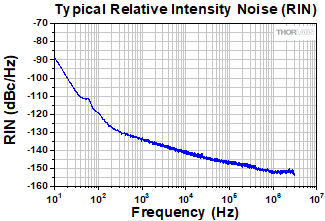 Click to Enlarge
Click to EnlargeFigure G1.1 This graph shows typical relative intensity noise (RIN) for our 780, 795, and 852 nm ULN lasers, measured with the PNA1 Intensity Noise Analyzer. See each device's individualized datasheet for specific performance.
- Center Wavelength of 780 nm or 795 nm
- >70 mW Output Power at the Rb D2 (Item # ULN780PC) or >100 mW Output Power at the Rb D1 (Item # ULN795PC) Nominal Vacuum Transition
- <10 kHz Linewidth
- -150 dBc/Hz Typical Relative Intensity Noise (RIN)
Thorlabs' ULN780PC and ULN795PC current-tuning lasers operate in a single mode. The ULN780PC is centered at 780 nm, corresponding to the D2 atomic transition line of rubidium (Rb), while the ULN795PC is centered at 795 nm, aligned with the D1 transition line of Rb. Each device includes an individualized data sheet, which provides the optimal temperature difference, ΔT, between the FBG and gain chip. A typical relative intensity noise (RIN) graph for these lasers can be seen in Figure G1.1.
See the info icon (![]() ) in Table G1.2 for typical performance specifications. These specifications are typical values and the performance will vary from device to device. Each ultra-low-noise laser diode is serialized and shipped with individual test data. Customers can click "Choose Item" below to view a variety of available center wavelengths. The reported specifications are achievable by using a low-noise current supply, such as our LNC31 low-noise laser diode driver.
) in Table G1.2 for typical performance specifications. These specifications are typical values and the performance will vary from device to device. Each ultra-low-noise laser diode is serialized and shipped with individual test data. Customers can click "Choose Item" below to view a variety of available center wavelengths. The reported specifications are achievable by using a low-noise current supply, such as our LNC31 low-noise laser diode driver.
This laser uses PM780-HP polarization maintaining fiber, which is terminated with an FC/APC, 2.0 mm narrow key connector. The fiber's slow axis is aligned parallel to the connector key.

 Click to Enlarge
Click to EnlargeFigure G2.1 This graph shows typical relative intensity noise (RIN) for our 780, 795, and 852 nm ULN lasers, measured with the PNA1 Intensity Noise Analyzer. See each device's individualized datasheet for specific performance.
- Center Wavelength of 852 nm
- >100 mW Output Power at the Cs D2 Nominal Vacuum Transition
- <10 kHz Linewidth
- -150 dBc/Hz Typical Relative Intensity Noise (RIN)
Thorlabs' ULN852PC ultra-low-noise current-tuning laser operates in a single mode. The ULN852PC laser is centered at 852 nm, corresponding to the D2 atomic transition line of cesium (Cs). Each device includes an individualized data sheet, which provides the optimal temperature difference, ΔT, between the FBG and gain chip. A typical relative intensity noise (RIN) graph for this laser can be seen in Figure G2.1.
See the info icon (![]() ) in Table G2.2 for typical performance specifications. These specifications are typical values and the performance will vary from device to device. Each ultra-low-noise laser diode is serialized and shipped with individual test data. Customers can click "Choose Item" below to view a variety of available center wavelengths. The reported specifications are achievable by using a low-noise current supply, such as our LNC31 low-noise laser diode driver.
) in Table G2.2 for typical performance specifications. These specifications are typical values and the performance will vary from device to device. Each ultra-low-noise laser diode is serialized and shipped with individual test data. Customers can click "Choose Item" below to view a variety of available center wavelengths. The reported specifications are achievable by using a low-noise current supply, such as our LNC31 low-noise laser diode driver.
This laser uses PM780-HP polarization maintaining fiber, which is terminated with an FC/APC, 2.0 mm narrow key connector. The fiber's slow axis is aligned parallel to the connector key.

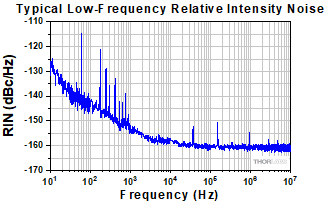 Click to Enlarge
Click to EnlargeClick for Data
Figure G3.1 Typical relative intensity noise graph for a 1550 nm ULN laser. See the individualized datasheet for each device to see specific performance.
- Center Wavelength of 1550 nm
- 20 pm Typical Mode-Hop-Free Tuning Range
- -165 dBc/Hz Typical Relative Intensity Noise (RIN)
- 0.25 pm/mA Current-Tuning Coefficient
Thorlabs' current-tuning ULN laser provides a wide range of currents over which the laser operates in a single mode, as compared to the temperature-tuning configuration sold below, maximizing the mode-hop-free current tuning range. In this configuration, it is not possible to independently adjust the temperature setpoints of the ULN gain chip and fiber Bragg grating (FBG) without reducing the mode-hop-free range. Each device includes an individualized data sheet, which provides the optimal temperature difference, ΔT, between the FBG and gain chip.
See the info icon (![]() ) in Table G3.2 for typical performance specifications.
) in Table G3.2 for typical performance specifications.
Current-Tuning vs. Temperature-Tuning Configurations
Our 1550 nm ultra-low-noise lasers are available in either a current- or temperature-tuning configuration. The current-tuning configuration is designed to maximize the range of drive currents where the laser operates in a single mode. The temperature-tuning configuration allows for independent adjustment of the FBG temperature without impacting the width of the mode-hop-free range. Users requiring the maximum possible mode-hop-free tuning and/or current range should select the current-tuning configuration, while users wishing to thermally tune the output wavelength without impacting the output power should select the temperature-tuning configuration. For more information on how these devices operate, see the SM Operation tab.
This laser uses Corning® PM15-U25D polarization maintaining fiber, which is terminated with an FC/APC, 2.0 mm narrow key connector. The fiber's slow axis is aligned parallel to the connector key.
We also offer a turnkey version of this laser diode. Please see the full ULN15TK laser system web presentation for more information.

 Click to Enlarge
Click to EnlargeClick for Data
Figure G4.1 Typical relative intensity noise graph for a 1550 nm ULN laser. See the individualized datasheet for each device to see specific performance.
- Center Wavelength of 1550 nm
- 500 pm Typical Temperature-Tuning Range
- -165 dBc/Hz Typical Relative Intensity Noise (RIN)
- 9 pm/K Temperature-Tuning Coefficient
Thorlabs' temperature-tuning ULN laser allows for independent adjustment of the fiber Bragg grating (FBG) temperature, providing a wide 500 pm typical tuning range without impacting the laser output power. See the info icon (![]() ) in Table G4.2 for typical performance specifications. Device-specific test data can be found in the individualized data sheets.
) in Table G4.2 for typical performance specifications. Device-specific test data can be found in the individualized data sheets.
Current-Tuning vs. Temperature-Tuning Configurations
Our 1550 nm ultra-low-noise lasers are available in either a current- or temperature-tuning configuration. The current-tuning configuration is designed to maximize the range of drive currents where the laser operates in a single mode. The temperature-tuning configuration allows for independent adjustment of the FBG temperature without impacting the width of the mode-hop-free range. Users requiring the maximum possible mode-hop-free tuning and/or current range should select the current-tuning configuration, while users wishing to thermally tune the output wavelength without impacting the output power should select the temperature-tuning configuration. Note that because the single mode regions move as the FBG temperature is adjusted, a ULN kept at a single current may not provide single mode operation at all temperatures. For more information on how these devices operate, see the SM Operation tab.
This laser uses Corning® PM15-U25D polarization maintaining fiber, which is terminated with an FC/APC, 2.0 mm narrow key connector. The fiber's slow axis is aligned parallel to the connector key.
 Products Home
Products Home

















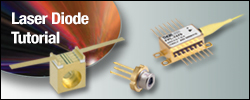


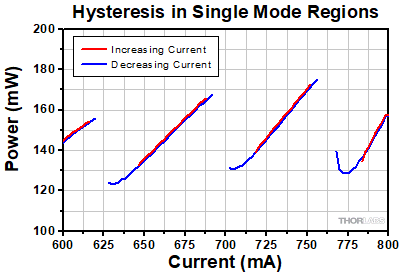 Click to Enlarge
Click to Enlarge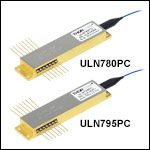
 ズーム
ズーム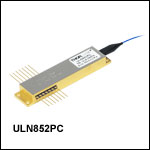
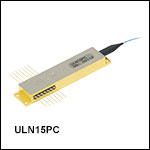

 超低ノイズ単一周波数レーザ拡張型バタフライパッケージ
超低ノイズ単一周波数レーザ拡張型バタフライパッケージ